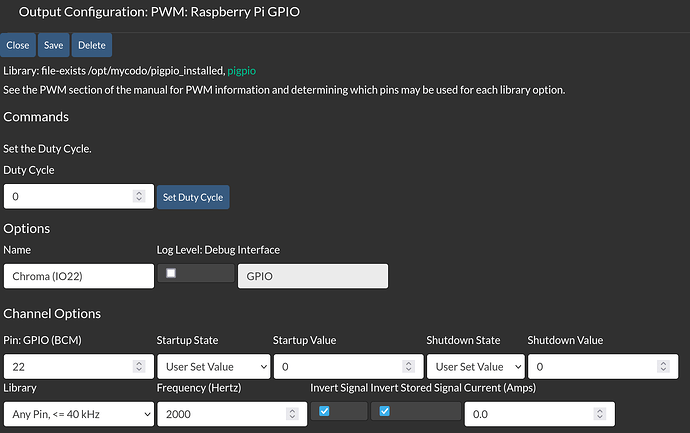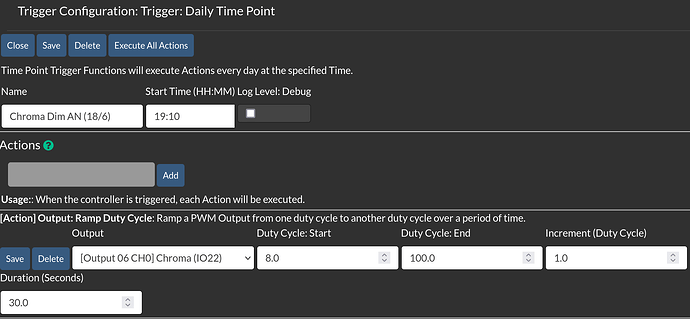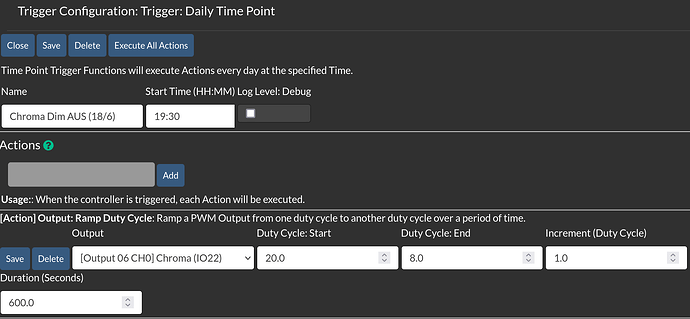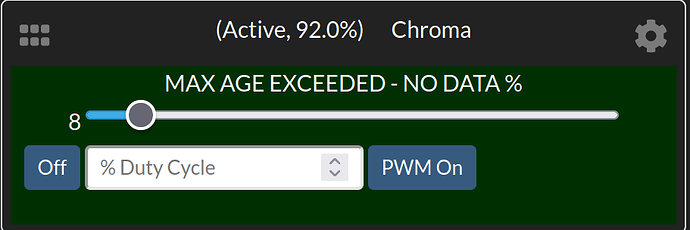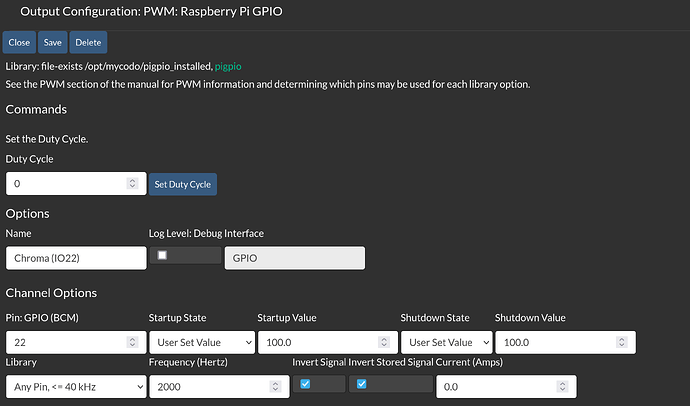This is the configuration of the output
The daily Trigger to ramp up the output
The daily Trigger to ramp down the output
When i “execute all actions” from the “Chroma Dim AUS (18/6)” the light goes on dims down to about 17%. It stays there about 30 seconds, then it goes off for another 30 seconds, then goes on again at 16%. And so on until it reaches 8%. After another 30 seconds the lamp goes on again and stays on.
The log file filtered for the guid of the output
2023-10-21 18:24:30,531 - DEBUG - mycodo.controllers.controller_output - output_on_off(a23dc437-a3e9-4a28-b54b-e17adad8e0b7, on, 0, pwm, 20.0, 0.0, True)
2023-10-21 18:24:30,866 - DEBUG - mycodo.influx - Write point success: b'percent,channel=0,device_id=a23dc437-a3e9-4a28-b54b-e17adad8e0b7,measure=duty_cycle value=20'
2023-10-21 18:25:20,496 - DEBUG - mycodo.controllers.controller_output - output_on_off(a23dc437-a3e9-4a28-b54b-e17adad8e0b7, on, 0, pwm, 19.0, 0.0, True)
2023-10-21 18:25:21,177 - DEBUG - mycodo.influx - Write point success: b'percent,channel=0,device_id=a23dc437-a3e9-4a28-b54b-e17adad8e0b7,measure=duty_cycle value=19'
2023-10-21 18:26:10,508 - DEBUG - mycodo.controllers.controller_output - output_on_off(a23dc437-a3e9-4a28-b54b-e17adad8e0b7, on, 0, pwm, 18.0, 0.0, True)
2023-10-21 18:26:10,939 - DEBUG - mycodo.influx - Write point success: b'percent,channel=0,device_id=a23dc437-a3e9-4a28-b54b-e17adad8e0b7,measure=duty_cycle value=18'
2023-10-21 18:27:00,495 - DEBUG - mycodo.controllers.controller_output - output_on_off(a23dc437-a3e9-4a28-b54b-e17adad8e0b7, on, 0, pwm, 17.0, 0.0, True)
2023-10-21 18:27:00,920 - DEBUG - mycodo.influx - Write point success: b'percent,channel=0,device_id=a23dc437-a3e9-4a28-b54b-e17adad8e0b7,measure=duty_cycle value=17'
2023-10-21 18:27:50,514 - DEBUG - mycodo.controllers.controller_output - output_on_off(a23dc437-a3e9-4a28-b54b-e17adad8e0b7, on, 0, pwm, 16.0, 0.0, True)
2023-10-21 18:27:50,948 - DEBUG - mycodo.influx - Write point success: b'percent,channel=0,device_id=a23dc437-a3e9-4a28-b54b-e17adad8e0b7,measure=duty_cycle value=16'
2023-10-21 18:28:40,495 - DEBUG - mycodo.controllers.controller_output - output_on_off(a23dc437-a3e9-4a28-b54b-e17adad8e0b7, on, 0, pwm, 15.0, 0.0, True)
2023-10-21 18:28:40,891 - DEBUG - mycodo.influx - Write point success: b'percent,channel=0,device_id=a23dc437-a3e9-4a28-b54b-e17adad8e0b7,measure=duty_cycle value=15'
2023-10-21 18:29:30,547 - DEBUG - mycodo.controllers.controller_output - output_on_off(a23dc437-a3e9-4a28-b54b-e17adad8e0b7, on, 0, pwm, 14.0, 0.0, True)
2023-10-21 18:29:31,006 - DEBUG - mycodo.influx - Write point success: b'percent,channel=0,device_id=a23dc437-a3e9-4a28-b54b-e17adad8e0b7,measure=duty_cycle value=14'
2023-10-21 18:30:20,498 - DEBUG - mycodo.controllers.controller_output - output_on_off(a23dc437-a3e9-4a28-b54b-e17adad8e0b7, on, 0, pwm, 13.0, 0.0, True)
2023-10-21 18:30:20,865 - DEBUG - mycodo.influx - Write point success: b'percent,channel=0,device_id=a23dc437-a3e9-4a28-b54b-e17adad8e0b7,measure=duty_cycle value=13'
2023-10-21 18:31:10,497 - DEBUG - mycodo.controllers.controller_output - output_on_off(a23dc437-a3e9-4a28-b54b-e17adad8e0b7, on, 0, pwm, 12.0, 0.0, True)
2023-10-21 18:31:10,970 - DEBUG - mycodo.influx - Write point success: b'percent,channel=0,device_id=a23dc437-a3e9-4a28-b54b-e17adad8e0b7,measure=duty_cycle value=12'
2023-10-21 18:32:00,529 - DEBUG - mycodo.controllers.controller_output - output_on_off(a23dc437-a3e9-4a28-b54b-e17adad8e0b7, on, 0, pwm, 11.0, 0.0, True)
2023-10-21 18:32:01,033 - DEBUG - mycodo.influx - Write point success: b'percent,channel=0,device_id=a23dc437-a3e9-4a28-b54b-e17adad8e0b7,measure=duty_cycle value=11'
2023-10-21 18:32:50,504 - DEBUG - mycodo.controllers.controller_output - output_on_off(a23dc437-a3e9-4a28-b54b-e17adad8e0b7, on, 0, pwm, 10.0, 0.0, True)
2023-10-21 18:32:50,952 - DEBUG - mycodo.influx - Write point success: b'percent,channel=0,device_id=a23dc437-a3e9-4a28-b54b-e17adad8e0b7,measure=duty_cycle value=10'
2023-10-21 18:33:40,478 - DEBUG - mycodo.controllers.controller_output - output_on_off(a23dc437-a3e9-4a28-b54b-e17adad8e0b7, on, 0, pwm, 9.0, 0.0, True)
2023-10-21 18:33:40,884 - DEBUG - mycodo.influx - Write point success: b'percent,channel=0,device_id=a23dc437-a3e9-4a28-b54b-e17adad8e0b7,measure=duty_cycle value=9'
2023-10-21 18:34:30,515 - DEBUG - mycodo.controllers.controller_output - output_on_off(a23dc437-a3e9-4a28-b54b-e17adad8e0b7, on, 0, pwm, 8.0, 0.0, True)
2023-10-21 18:34:31,367 - DEBUG - mycodo.influx - Write point success: b'percent,channel=0,device_id=a23dc437-a3e9-4a28-b54b-e17adad8e0b7,measure=duty_cycle value=8'
2023-10-21 18:35:20,450 - DEBUG - mycodo.controllers.controller_output - output_on_off(a23dc437-a3e9-4a28-b54b-e17adad8e0b7, on, 0, pwm, 8.0, 0.0, True)
2023-10-21 18:35:20,675 - DEBUG - mycodo.influx - Write point success: b'percent,channel=0,device_id=a23dc437-a3e9-4a28-b54b-e17adad8e0b7,measure=duty_cycle value=8'
This is a synchronous graph of the output
I have absolutly no clue what is causing the on/off behaviour starting at 17%
and no clue what is causing the PWM to turn off.
On the mosfet board there is a LED showing if the signal has PWM.
Hence i think some other task (builtin timer) is turning of the PWM signal on the GPIO pin.
But it could be very well a configuration error.
Thanks, and I get it. However since i now have the possibility to do so. I’d like to try it as a proof of concept.
I would be totally fine, if this it not possible at all, to just turn it on and off.
However this is not possible, as even the simple function to turn off:
does only work for about 30 seconds…
ps all the times, durations and percentages are just for testing the scenario.
